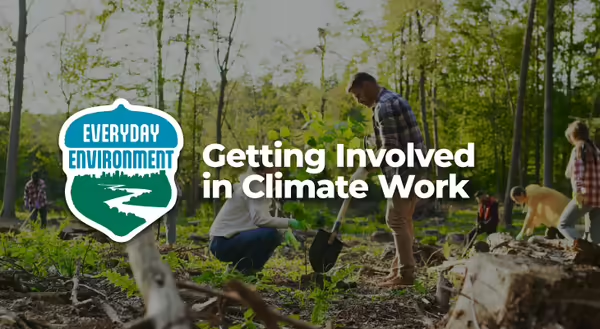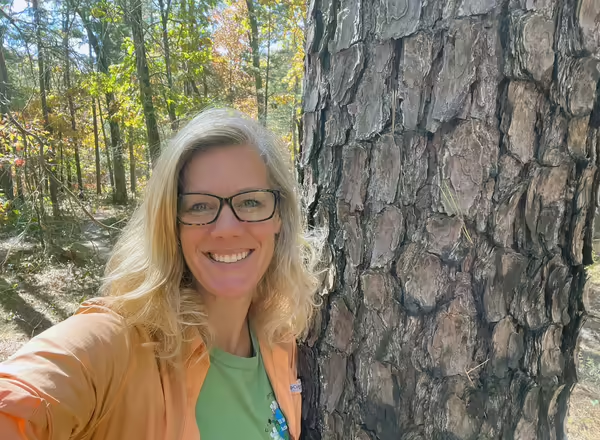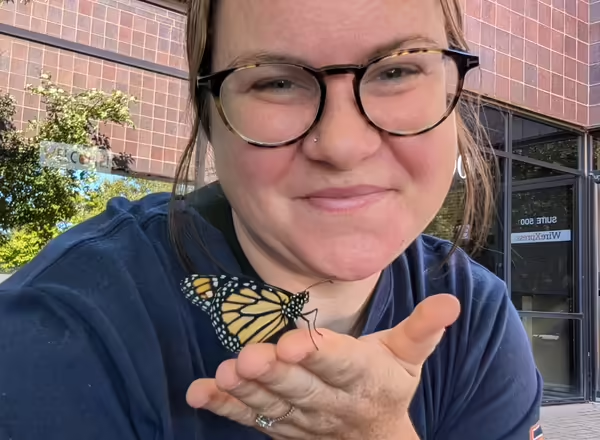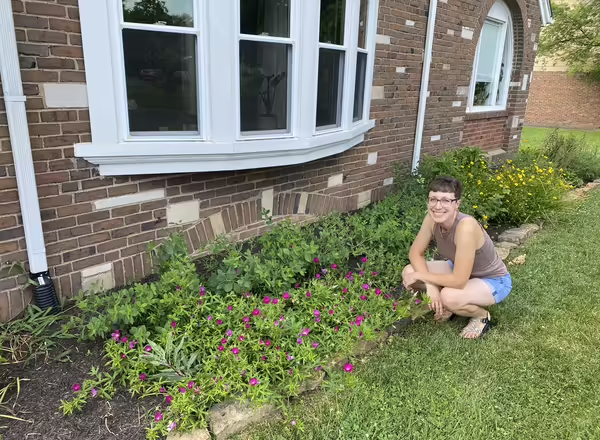
This fall, as Everyday Environment explored the different facets of climate change, we — Amy, Abigail, and Erin — also learned a lot along the way, just like we hope you did! With such a broad topic, there were so many different areas that we could dive into and really explore. Across these 12 weeks, we’ve broadened our view of actions occurring to help mitigate and adapt to climate change. Looking back at what we’ve learned, we wanted to share the takeaways each host took from this season, and we encourage you to think about what are your own takeaways.
Explore the full collection of climate change videos, blogs, and podcasts on the Everyday Environment page.

Amy’s Takeaway
Goosebumps….over climate change?
As a host, I was very excited to learn more and dive deeper into the facts of climate science, climate change, and how climate directly impacts our lives. As we have progressed through the season, I’ve had a few “goosebump” moments — the times when the information became more clear and stuck like Velcro in my mind! Here are my goosebump moments.
Our atmosphere is incredible! As our podcast, Shifting to a Silver Lining: Climate Expert Talks Climate Change with climate scientist Justin Schoof explains, our atmosphere allows light energy from the sun to pass through but keeps just enough heat energy within our system for us to survive. Just enough. A slightly different atmospheric gas composition, and we would be Mars or Venus. What?! Isn’t it amazing how perfect our Earth is? Goosebumps…It made me realize just how critical our atmosphere is to our existence and reinforced the need to take inventory of my individual actions that impact our atmosphere.
All three phases of water in one package. Another climate science basics “aha” moment was the fact that our planet exhibits temperature and pressure levels that allow water to exist in all three phases. Now, we already know this from our elementary science classes, but to take it further, Schoof explained that changing water phases releases energy especially when gaseous water vapor changes to liquid precipitation — hence, our severe weather events. Climate trends are showing more frequent severe weather events. Understanding the science behind these trends helps to make sense of what is happening. To take it a step further, understanding the science reveals to us how our community infrastructure is at risk from more severe storms and flooding.
Back to photosynthesis basics. My 7th-grade daughter had a photosynthesis question on her test review that could've been answered by our How Plants Respond to Rising Carbon Dioxide Concentrations blog. My daughter rattled off the photosynthesis equation from memory and we moved to the next critical thinking question. The question was, “Our climate is changing due to higher carbon dioxide levels in the atmosphere. If there is more carbon dioxide in the atmosphere, what effects would this have on photosynthesis in plants?” Wow, another instance of climate in a separate part of life. It is like how you might notice how a specific car suddenly seems to appear everywhere once you start looking for it.
Climate is everywhere. Climate impacts us more than simply what is happening outside our window. A shift in our climate affects decisions made on my family’s farm operation, it affects how we manage invasive plants in our woodlands, it affects our health and wellness during outdoor activities, it affects what tree I plant in my yard, and it impacts property insurance premiums. Within this series, I had a sense of duty wash over me about my responsibility and influence as an individual, as a parent, as an educator, and as a community member to address climate challenges. Yet, in listening to the series and learning about the actions we can take, I also had a feeling of inspiration.

Abigail’s Takeaway
Your individual actions matter. Each person can still reflect and make changes that are beneficial.
We often think that deniers of the science of climate change are commonplace. We don’t talk about climate change or even utter the words given the potential conflict it could cause with friends, family, or neighbors. It’s that old cliche: “Da Nile (denial) ain’t just a river in Egypt” right?
However, according to the Yale Program on Climate Communications, only 22% percent of Americans fall into that category, and half of those have the most extreme mindset of doubtfulness. That means that 78% of Americans are at the very least disengaged from the issue and at the very most alarmed. That’s why I think a more appropriate cliche on climate change is “da spare (despair) ain’t just an extra tire in the back of your car.” That’s where a lot of us sit in this issue of climate change, feeling isolated, overwhelmed, and downtrodden about an issue that is too large, too complex, and too distant to make it feel like individual actions make a difference. Everyday Environment has shown me that that is simply not true.
There are so many actions and cultural shifts that give individuals the power to make a difference in this grand challenge. There are lifestyle changes such as how we manage our landscapes and how we use energy, to what we do with our food waste. There are community changes, from talking with our decision-makers about what matters to us or volunteering for a local organization addressing these issues.
And finally, there are cultural changes in how we choose to talk with our friends, neighbors, and family about this issue. We never know if the person we talk to has the power to make a difference on a grand scale and at the very least, offers solidarity in the concerns and anxiety related to this issue. Everyone has the power to move the dial on this grand challenge, and it will take all of us to do it. This series has shown me that we are not alone in addressing climate change.

Erin’s Takeaway
More work is being done to address climate change than you might think — even if the main purpose isn’t always climate-motivated.
As Abigail said, climate change mitigation and adaptation can feel too large and complex to even begin to start to address. We hope that during this season, we’ve broken down different sectors to showcase how they are making advances in their practices that have positive environmental benefits. We’ve talked to guests who represent many different industries, such as agriculture, forestry, public health, energy, and community development. Whether climate-motivated or not, these industries are adopting practices that have the collective result of helping us mitigate and adapt to climate change.
In agriculture, the willingness to explore dual-purpose croplands for food and energy production is a great step forward in exploring how we can use land, a crucial and limited resource, for more than one purpose. Is there potential for this dual production to increase the value of that land? Perhaps a financial motivation might be a reason for agricultural producers to explore this avenue, rather than a climate-only motivation.
In the public health sector, increased awareness of the impacts of heat-related weather events, flooding impacts, and diseases from ticks and mosquitos can help improve health outcomes, with the ultimate outcome of building a more climate-resilient and healthy community.
In densely populated areas, improving the connectedness of communities and expanding a diverse array of public transportation options could be one way to help reduce emissions, but it also leads to a more connected society with improved access to resources for all community members.
Arborists and landscapers might consider planting trees that are more resilient to a broader range of environmental conditions, which can lower their overall maintenance costs and decrease the amount of replacements that need to be planned for. This resilience has additional benefits of diversifying urban tree canopy to better withstand pests and diseases and helping cool our communities.
The motivations for making change are often multifaceted, but I’ve been excited to see the positive outcomes that are occurring for climate change goals because of these changes across so many sectors of society.
What’s coming next? In Spring 2025 we're exploring all things water!
This wraps up our first season of the new Everyday Environment. We hope you’ve enjoyed our exploration of climate change. We are already in the process of planning season two, which will be focused on all things water. We hope you join us as we take the deep dive to explore how we interact with water on a daily basis, from raindrops to what comes out of your faucet, in the ways you see and the ways you don’t see. We’ll explore how our individual and collective actions impact water, its quality and quantity, and where it goes. Stay tuned, we’ll be back in March 2025!
In the meantime, please explore and share our season one content across our blog, podcast, short videos, and webinars. If you have questions about your Everyday Environment or suggestions for topics you’d like to see us cover in season two, feel free to email us and let us know your thoughts! You can also always connect with your local Illinois Extension office at go.illinois.edu/ExtensionOffice.
Thank you for reading!
Everyday Environment is a series of blogs, podcasts, webinars and videos on exploring the intricate web of connections that tie us to the natural world. Check out the podcast episode on this topic to hear from Duane Friend about getting involved in climate work.